Abstract
A population based case-control study was performed in Cracow, Poland, to determine the effect of occupational air pollutants on various histological types of lung cancer. Male cases and controls were identified from the Cracow Death Register. Information was obtained by mailed questionnaire from next of kin on smoking, occupational branch, occupational exposures, and other pertinent variables. Response rates were 73.5% in cases and 72.0% in controls. For cases that underwent a bronchial biopsy or surgical excision the histological diagnosis of the tumour was obtained from clinical records. The case group contained 343 subjects with squamous cell carcinomas, 151 with small cell carcinomas, and 106 with adenocarcinomas. Twenty seven cases showed other histological types (large cell carcinoma and not classifiable). Analysis was performed separately by histological type for occupational exposure variables adjusted for smoking. Long term exposure to mineral dust and metal dust (20 years or more) was found to be a significant risk factor for small cell and squamous cell carcinoma. The effect was more pronounced if the analysis was restricted to those aged less than 70 years. The highest relative risk (RR) due to occupational exposures was found for squamous cell carcinoma and exposure to mineral dust for more than 20 years (RR = 2.45, 95% CI 1.43-4.19). The estimated effect of mineral dust on small cell carcinoma and adenocarcinoma was smaller (RR = 2.29, 95% CI 1.16-4.53 and RR = 2.04, 95% CI 0.89-4.64 respectively). The effect of metal dust and fumes seemed about the same for squamous and small cell carcinoma. No specific agent could be identified as particularly important for a specific histological type; it rather seemed that the effects of the substances considered were similar for lung cancers in general.
Full text
PDF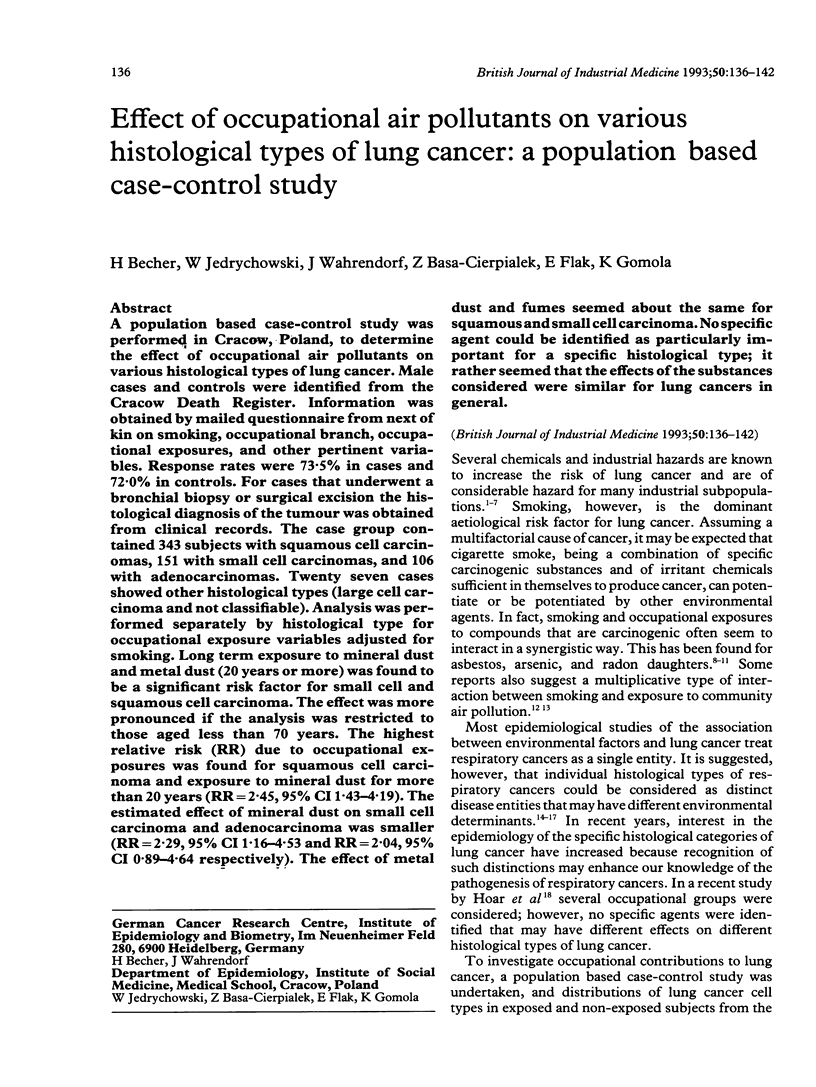
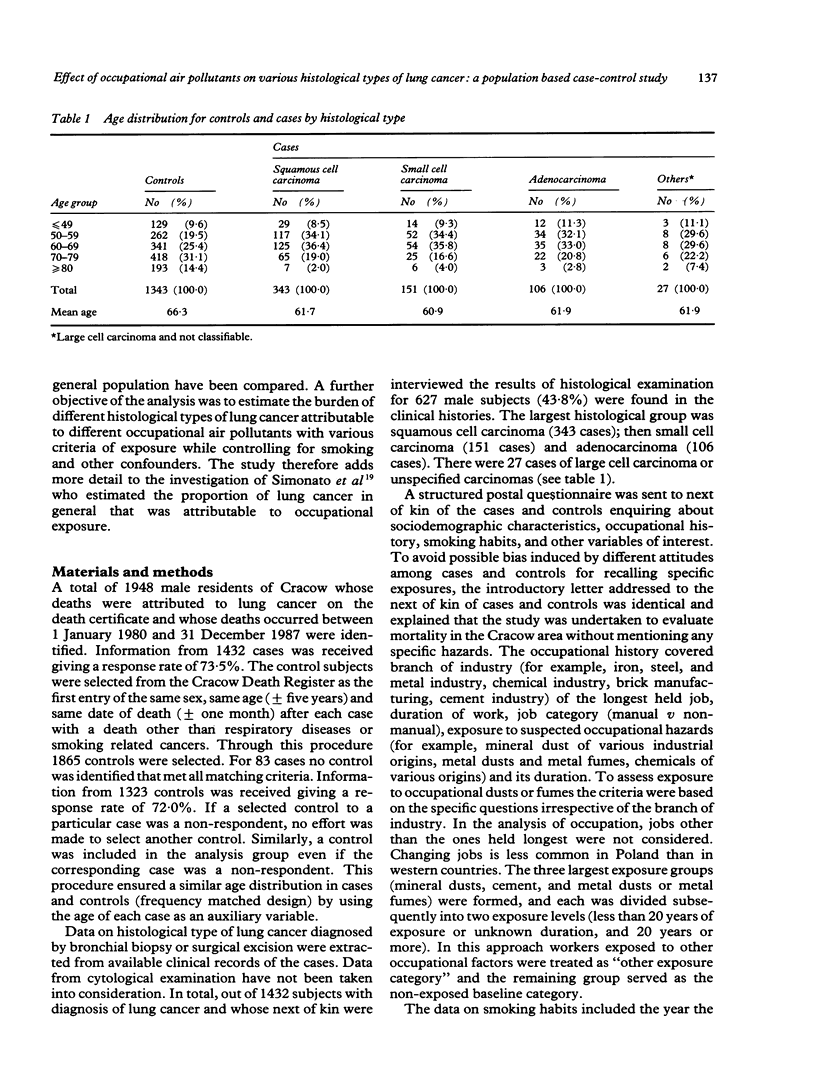
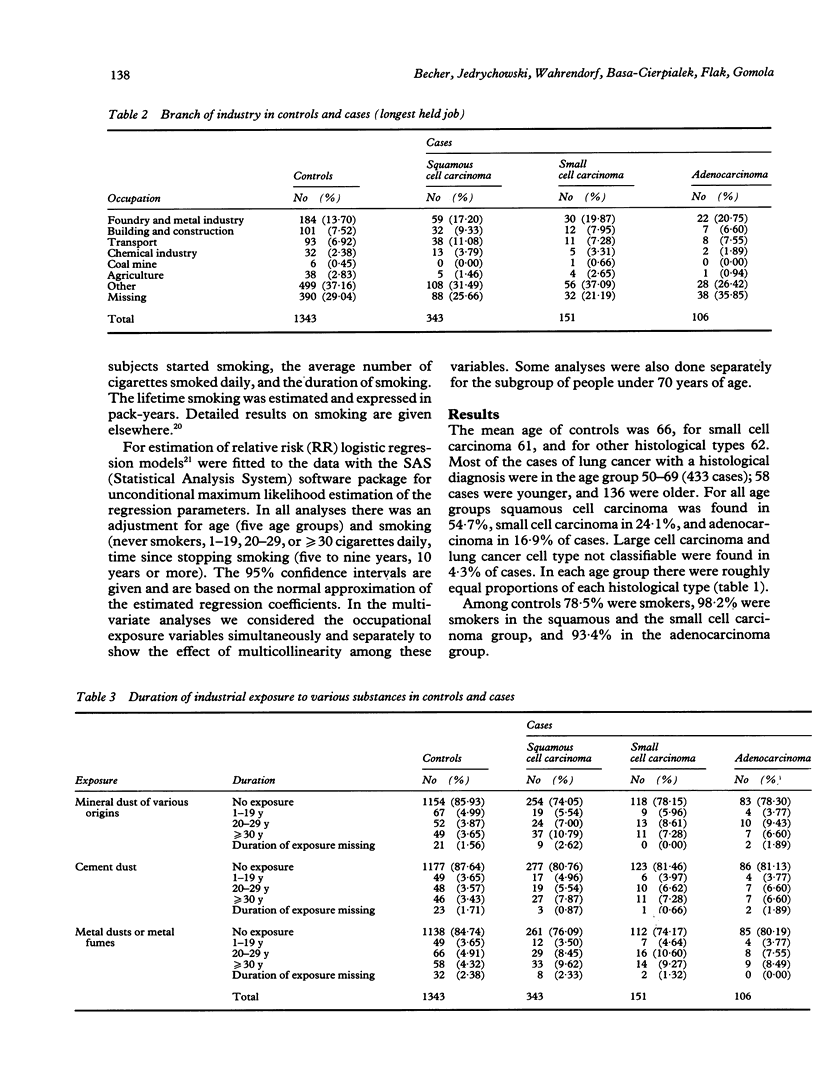
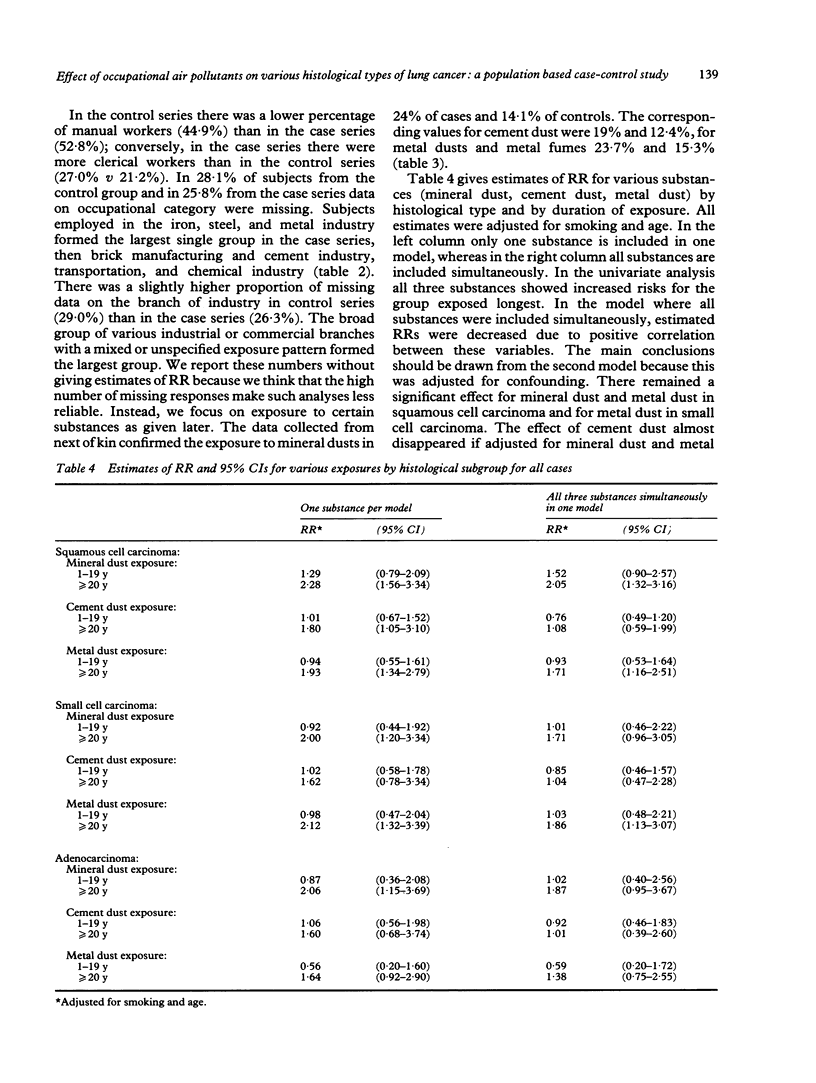

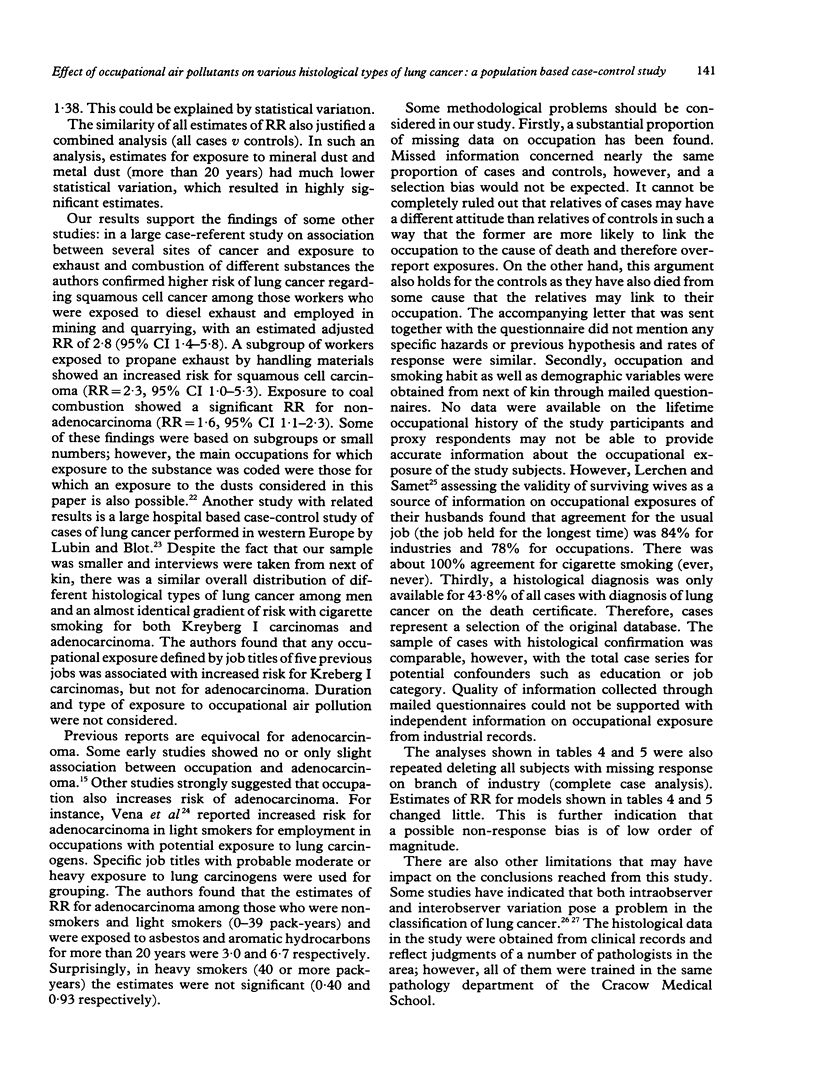
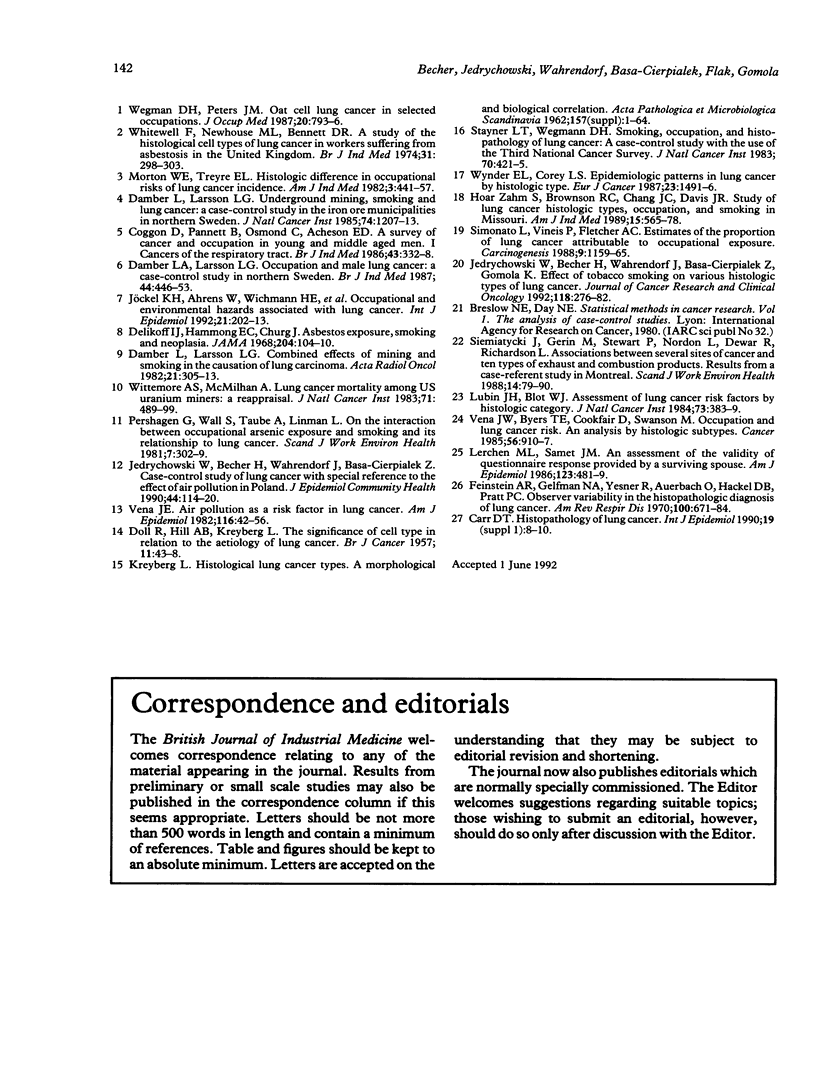
Selected References
These references are in PubMed. This may not be the complete list of references from this article.
- Carr D. T. Histopathology of lung cancer. Int J Epidemiol. 1990;19 (Suppl 1):S8–10. doi: 10.1093/ije/19.supplement_1.s8. [DOI] [PubMed] [Google Scholar]
- Coggon D., Pannett B., Osmond C., Acheson E. D. A survey of cancer and occupation in young and middle aged men. I. Cancers of the respiratory tract. Br J Ind Med. 1986 May;43(5):332–338. doi: 10.1136/oem.43.5.332. [DOI] [PMC free article] [PubMed] [Google Scholar]
- DOLL R., HILL A. B., KREYBERG L. The significance of cell type in relation to the aetiology of lung cancer. Br J Cancer. 1957 Mar;11(1):43–48. doi: 10.1038/bjc.1957.6. [DOI] [PMC free article] [PubMed] [Google Scholar]
- Damber L. A., Larsson L. G. Occupation and male lung cancer: a case-control study in northern Sweden. Br J Ind Med. 1987 Jul;44(7):446–453. doi: 10.1136/oem.44.7.446. [DOI] [PMC free article] [PubMed] [Google Scholar]
- Damber L., Larsson L. G. Combined effects of mining and smoking in the causation of lung carcinoma. A case-control study in northern Sweden. Acta Radiol Oncol. 1982;21(5):305–313. doi: 10.3109/02841868209134020. [DOI] [PubMed] [Google Scholar]
- Damber L., Larsson L. G. Underground mining, smoking, and lung cancer: a case-control study in the iron ore municipalities in northern Sweden. J Natl Cancer Inst. 1985 Jun;74(6):1207–1213. [PubMed] [Google Scholar]
- Feinstein A. R., Gelfman N. A., Yesner R. Observer variability in the histopathologic diagnosis of lung cancer. Am Rev Respir Dis. 1970 May;101(5):671–684. doi: 10.1164/arrd.1970.101.5.671. [DOI] [PubMed] [Google Scholar]
- Jedrychowski W., Becher H., Wahrendorf J., Basa-Cierpialek Z. A case-control study of lung cancer with special reference to the effect of air pollution in Poland. J Epidemiol Community Health. 1990 Jun;44(2):114–120. doi: 10.1136/jech.44.2.114. [DOI] [PMC free article] [PubMed] [Google Scholar]
- Jedrychowski W., Becher H., Wahrendorf J., Basa-Cierpialek Z., Gomola K. Effect of tobacco smoking on various histological types of lung cancer. J Cancer Res Clin Oncol. 1992;118(4):276–282. doi: 10.1007/BF01208616. [DOI] [PubMed] [Google Scholar]
- Jöckel K. H., Ahrens W., Wichmann H. E., Becher H., Bolm-Audorff U., Jahn I., Molik B., Greiser E., Timm J. Occupational and environmental hazards associated with lung cancer. Int J Epidemiol. 1992 Apr;21(2):202–213. doi: 10.1093/ije/21.2.202. [DOI] [PubMed] [Google Scholar]
- KREYBERG L. Histological lung cancer types. A morphological and biological correlation. Acta Pathol Microbiol Scand Suppl. 1962;Suppl 157:1–92. [PubMed] [Google Scholar]
- Lerchen M. L., Samet J. M. An assessment of the validity of questionnaire responses provided by a surviving spouse. Am J Epidemiol. 1986 Mar;123(3):481–489. doi: 10.1093/oxfordjournals.aje.a114263. [DOI] [PubMed] [Google Scholar]
- Lubin J. H., Blot W. J. Assessment of lung cancer risk factors by histologic category. J Natl Cancer Inst. 1984 Aug;73(2):383–389. doi: 10.1093/jnci/73.2.383. [DOI] [PubMed] [Google Scholar]
- Morton W. E., Treyve E. L. Histologic differences in occupational risks of lung cancer incidence. Am J Ind Med. 1982;3(4):441–457. doi: 10.1002/ajim.4700030409. [DOI] [PubMed] [Google Scholar]
- Pershagen G., Wall S., Taube A., Linnman L. On the interaction between occupational arsenic exposure and smoking and its relationship to lung cancer. Scand J Work Environ Health. 1981 Dec;7(4):302–309. doi: 10.5271/sjweh.2544. [DOI] [PubMed] [Google Scholar]
- Siemiatycki J., Gérin M., Stewart P., Nadon L., Dewar R., Richardson L. Associations between several sites of cancer and ten types of exhaust and combustion products. Results from a case-referent study in Montreal. Scand J Work Environ Health. 1988 Apr;14(2):79–90. doi: 10.5271/sjweh.1949. [DOI] [PubMed] [Google Scholar]
- Simonato L., Vineis P., Fletcher A. C. Estimates of the proportion of lung cancer attributable to occupational exposure. Carcinogenesis. 1988 Jul;9(7):1159–1165. doi: 10.1093/carcin/9.7.1159. [DOI] [PubMed] [Google Scholar]
- Stayner L. T., Wegman D. H. Smoking, occupation, and histopathology of lung cancer: a case-control study with the use of the Third National Cancer Survey. J Natl Cancer Inst. 1983 Mar;70(3):421–426. [PubMed] [Google Scholar]
- Vena J. E. Air pollution as a risk factor in lung cancer. Am J Epidemiol. 1982 Jul;116(1):42–56. doi: 10.1093/oxfordjournals.aje.a113401. [DOI] [PubMed] [Google Scholar]
- Vena J. E., Byers T. E., Cookfair D., Swanson M. Occupation and lung cancer risk. An analysis by histologic subtypes. Cancer. 1985 Aug 15;56(4):910–917. doi: 10.1002/1097-0142(19850815)56:4<910::aid-cncr2820560436>3.0.co;2-4. [DOI] [PubMed] [Google Scholar]
- Wegman D. H., Peters J. M. Oat cell lung cancer in selected occupations: a case-control study. J Occup Med. 1978 Dec;20(12):793–796. [PubMed] [Google Scholar]
- Whittemore A. S., McMillan A. Lung cancer mortality among U.S. uranium miners: a reappraisal. J Natl Cancer Inst. 1983 Sep;71(3):489–499. [PubMed] [Google Scholar]
- Whitwell F., Newhouse M. L., Bennett D. R. A study of the histological cell types of lung cancer in workers suffering from asbestosis in the United Kingdom. Br J Ind Med. 1974 Oct;31(4):298–303. doi: 10.1136/oem.31.4.298. [DOI] [PMC free article] [PubMed] [Google Scholar]
- Wynder E. L., Covey L. S. Epidemiologic patterns in lung cancer by histologic type. Eur J Cancer Clin Oncol. 1987 Oct;23(10):1491–1496. doi: 10.1016/0277-5379(87)90091-5. [DOI] [PubMed] [Google Scholar]
- Zahm S. H., Brownson R. C., Chang J. C., Davis J. R. Study of lung cancer histologic types, occupation, and smoking in Missouri. Am J Ind Med. 1989;15(5):565–578. doi: 10.1002/ajim.4700150509. [DOI] [PubMed] [Google Scholar]


